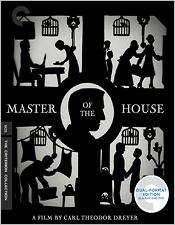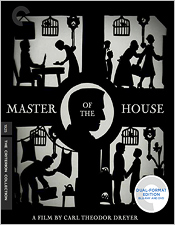Master of the House (Blu-ray Review)

Director
Carl Theodor DreyerRelease Date(s)
1925 (April 22, 2014)Studio(s)
Janus Films/Palladium (Criterion - Spine #706)- Film/Program Grade: B+
- Video Grade: B
- Audio Grade: B+
- Extras Grade: C+
Review
Master of the House (aka Du skal ære din hustru, or Thou Shalt Honour Thy Wife in English) tells the story of a Danish family with a tyrannical father figure whose persona causes much discontent in an unhappy home. Soon his thoughtlessness and carelessness are used against him as he is made to endure what the women and children in his life have endured at the cruel command of himself, which is the only way that he can get his wife back and the family can become whole once again.
Carl Theodor Dreyer directed this film in 1925 before his success with the films The Passion of Joan of Arc and Vampyr (both of which audiences are the most familiar with). He only made a handful of films before he passed away in 1968, but very few had success overseas, and he made even less of them with sound. Since then, especially in Denmark, his work has been re-evaluated and has had very good cult status with film fans. Master of the House was a major success for Dreyer when it was released in Denmark, but not so much in the United States. Art houses and world cinema enthusiasts have brought it back to life, as well as showings on the Turner Classic Movies channel.
The strange thing about its release abroad is that when it was distributed outside of Denmark, the intertitles were changed and didn’t make use of translations from Danish. Not only that, but all of the characters’ names were changed to be more accepted by English-speaking audiences. In Great Britain, distributors went so far as to put up an extra intertitle at the beginning of the film, proclaiming that they, as a country, were more advanced than the characters in the film. The very nature of the film is basically a rebirth of a character. The father of the story basically realizes what a “foolish man” he is and learns through much suffering what it’s like to be a woman who must give all of her time and energy to pleasing husband.
Now I wouldn’t go so far as to call this a perfect masterpiece from beginning to end. Despite being a marvelous film that should hold one’s interest all the way through quite powerfully, I found the subject matter oversimplified and a bit out of date. I’m not going to knock points off for the latter because it captures a moment in time and you have to always keep that in mind when you’re watching something, but oversimplification and the full-blown conclusion that you know is coming is a bit far-fetched. The film is basically a love story, but it’s more of a love story about families rather than lovers. There are plenty of subtle story-telling moments in the visuals and some very good editing, but the film feels like it’s running a bit too long at times. Again, this all may be because of how much more advanced audiences are today when it comes to the pace of a film; but one can’t deny that it basically drags at times, hitting the nail over the head of an idea or a story mechanic that really should have moved on from two or three minutes sooner.
Regardless of all of that, Master of the House is still a beautiful film, told by an innovative storyteller. It may not throw you any curve balls or leave you with any sense of wonder and awe, but it’s damn fine dramatic cinema.
Criterion chose to utilize a recent 2K restoration of a duplicate negative of the film that was carried out by Palladium in Denmark. The results are, well, the results are as good as we’re possibly going to get, in all honesty. Not only was a duplicate negative used, but in the insert booklet provided (which goes into much greater detail about the restoration than I will), it is noted that “other materials” were also used. So the film looks as good as it possibly can. The images carry interlaced encoding, and contain lots of missing frames, as well as some leftover film damage. However, every step to clean up this footage that could be taken has been carried out without destroying the integrity of the original negative. Even the flicker from the cranking of the camera hasn’t been modified or improved upon. All of that having been said, this is still a very good-looking presentation. It carries some strong images with fine detail, although some shots are out of focus (which likely stems from the original photography). Blacks are quite deep, and even though there’s some overexposure, the brightness and contrast levels are acceptable. It’s worth pointing out that this is a much better presentation than I’m making it sound. The efforts that went into creating it are staggering. It’s just unfortunate that a close-to-pristine original negative source couldn’t be unearthed somehow... but that’s a pipe dream for a film that’s going on 100 years old. It should also be duly noted that for this release, new intertitles have been created. The previously-used intertitles for English-language distribution were not used. Instead, the text is a direct translation from Danish for the first time.
As far as the soundtrack goes, which is a LPCM stereo track with score only, it’s quite beautiful and a real treat to listen to. It’s a reconstruction of the film’s original music that was played at its premier in Copenhagen in 1925. Pianist Sara Davis Buechner’s work is quite lush and melodic, and represented well on this uncompressed track. There’s nothing to note as far as speaker activity, but I felt I was right next to the piano while watching the film. It’s a lovely soundtrack and works with the images and story perfectly.
And as for supplemental material, it’s pretty light but well-worth digging into. The first of it is an interview with Danish film historian Casper Tybjerg, the second is a visual essay on the film by film scholar David Bordwell, and the third and final is a 22-page insert booklet with an essay about the film by film scholar Mark Le Fanu. There’s also, of course, the DVD version that’s also included in this Dual Format package. All of this material bears a lot of merit. The interview, for instance, goes into detail about some deleted scenes that haven’t survived, providing stills of them instead. The visual essay is also enlightening, and covers many of the film’s subtle visual details.
All in all, this is another terrific release from Criterion. I daresay I wasn’t even aware of Master of the House before picking this disc up, and it’s that reason why Criterion exists in the first place: to bring world-class cinema, especially unseen cinema, to the masses for a better appreciation of it. And with this release, they won me over completely, and I have a feeling that they will win you over too.
- Tim Salmons

